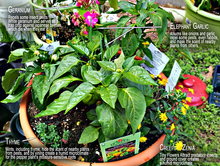Establishment
Bed preparation

Bed preparation is an important and time-consuming activity that is vital to the success of a French intensive garden, beginning with the bed layouts which are often what people associate with the French intensive system. A 3x3 foot bed is the minimum size needed to create the micro climates necessary for successful planting, however most prefer a bed length of 5, 10, or 20 feet to make calculations easier and yields larger. [6] Traditionally, raised beds are the first image to come to mind when thinking of a French intensive garden. However, bed heights should be adjusted to the climates they are being built in, with drier climates having flat or sunken to maximize water collection and wetter or temperate climates utilizing raised beds. [4] Heights vary from 1–2 inches for warmer climates to 6–8inches in colder areas where soil heat needs to be conserved. [4]
After the garden has been laid out, soil preparation is the next key aspect to consider for successful planting. Weeds and debris are removed from the beds and 3–4 inches of compost or manure is dug into the soil and left for a month in order to have nutrients spread around the soil; the process can be sped up by placing black or clear plastic tarps over the soil causing a pre-heating of the ground. [1] Double-digging, is the technique often used to create well aerated and evenly dispersed nutrients in the soil. [6] Proper soil preparation is key to aiding in plant growth using French intensive companion planting.

Companion planting
French intensive gardening relies on companion planting to create the high volumes it is known for. [4] Optimal spacing is achieved when the mature plants have their leaves barely brushing each other, creating a micro-canopy protecting the soil and keeping unwanted weeds at bay. [1] Companion planting in French intensive gardening maximizes the amount of space in the bed used for planting, leaving little if any unused space and has three different forms, intercropping, trap-cropping, and companion planting. Each of the three forms involve growing two or more plants in close proximity so that they improve the growth of each other. Intercropping is most effective when it involves planting two plants of opposite needs or characteristics together; slow growing plants with faster ones, shorter rooted plant with longer rooted ones, taller plants with shorter ones. [4] Trap-cropping involves planting flowering plants near growing produce to attract pollinating insects, and the third form, also known as companion planting, involves planting two or more crops together in order to improve flavors. [1] Companion planting for flavor has limited scientific backing, unlike intercropping and trap-cropping.